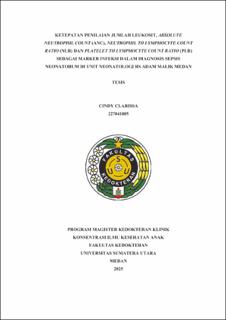Ketepatan Penilaian Jumlah Leukosit, Absolute Neutrophil Count (ANC), Neutrophil to Lymphocyte Count Ratio (NLR) dan Platelet to Lymphocyte Count Ratio (PLR) sebagai Marker Infeksi dalam Diagnosis Sepsis Neonatorum di Unit Neonatologi RS Adam Malik Medan
Accuracy of Leukocyte Count, Absolute Neutrophil Count (ANC), Neutrophil to Lymphocyte Ratio (NLR) And Platelet to Lymphocyte Ratio (PLT) as Markers in Diagnosis of Neonatal Sepsis in Neonatology Unit Adam Malik Hospital Medan

Date
2025Author
Sirait, Cindy Clarissa
Advisor(s)
Pasaribu, Ayodhia Pitaloka
Tanjung, Ika Citra Dewi
Metadata
Show full item recordAbstract
Background: Neonatal sepsis is one of the most common causes of neonatal death in the first month of life. Neonatal sepsis often shows atypical clinical features of infection and blood culture as the gold standard test often gives false negative results, posing a major challenge in its diagnosis and management. Early diagnosis and timely intervention are essential to improve the prognosis of infants with sepsis.
Objective: To determine the cut off value, sensitivity, specificity, positive predictive value (PPV), negative predictive value (NPV), positive likelihood ratio (LR +), negative likelihood ratio (LR -), pretest odds and post test odds and accuracy of each infection marker (leukocytes, ANC, NLR, and PLR) compared to blood culture.
Method: Retrospective cohort analytic study to assess leukocytes, ANC, NLR, and PLR in diagnosing neonatal through digital medical records of patients admitted to the Neonatology Unit of Adam Malik Hospital Medan from July 2023 to July 2024 with a consecutive sampling. Data were analyzed using the Statistical Package for Social Sciences for Windows (SPSS) version 24.0 for Windows computer program to see the relationship between related parameters and the Cat Maker computer program to assess diagnostic tests. The Mann Whitney test and Fisher test were used to analyze sample characteristics. If the p value was <0.05, it was concluded that there was a significant difference between groups.
Result: 51 patients were confirmed with positive blood culture results and 49 patients with negative blood culture. The majority of patients with neonatal sepsis were female (55%), full-term gestational age (54%), adequate birth weight (48%) and born by sectio cesarea (79%). Leukocyte count as a marker of neonatal sepsis infection had a sensitivity of 82.3%, specificity of 83.6%, PPV 84%, NPV 82%, LR+ 5, LR- 0.21, pretest odds 1.02, posttest odds 5.1, and accuracy 83%. The ANC value had a sensitivity of 90.1%, specificity of 91.8%, PPV of 92%, NPV of 90%, LR+ 10.9, LR- 0.10, pretest odds 1, posttest odds 10.9, and accuracy of 91%. The NLR value had a sensitivity of 90.1%, specificity of 89.7%, PPV of 90.1%, NPV of 89.7%, LR+ 8.74, LR- 0.11, pretest odds 1.04, posttest odds 9.09, and accuracy of 90%. PLR values had a sensitivity of 92.1%, specificity of 93.8%, PPV of 94%, NPV of 92%, LR+ 14.8, LR- 0.08, pretest odds 1.02, posttest odds 15.09 and accuracy of 93%.
Conclusion: Leukocyte, ANC, NLR and PLR can be used as alternative examinations in the diagnosis of neonatal sepsis. The best infection markers are PLR and ANC. The combination of two infection markers did not show better results when compared with single infection marker values.
